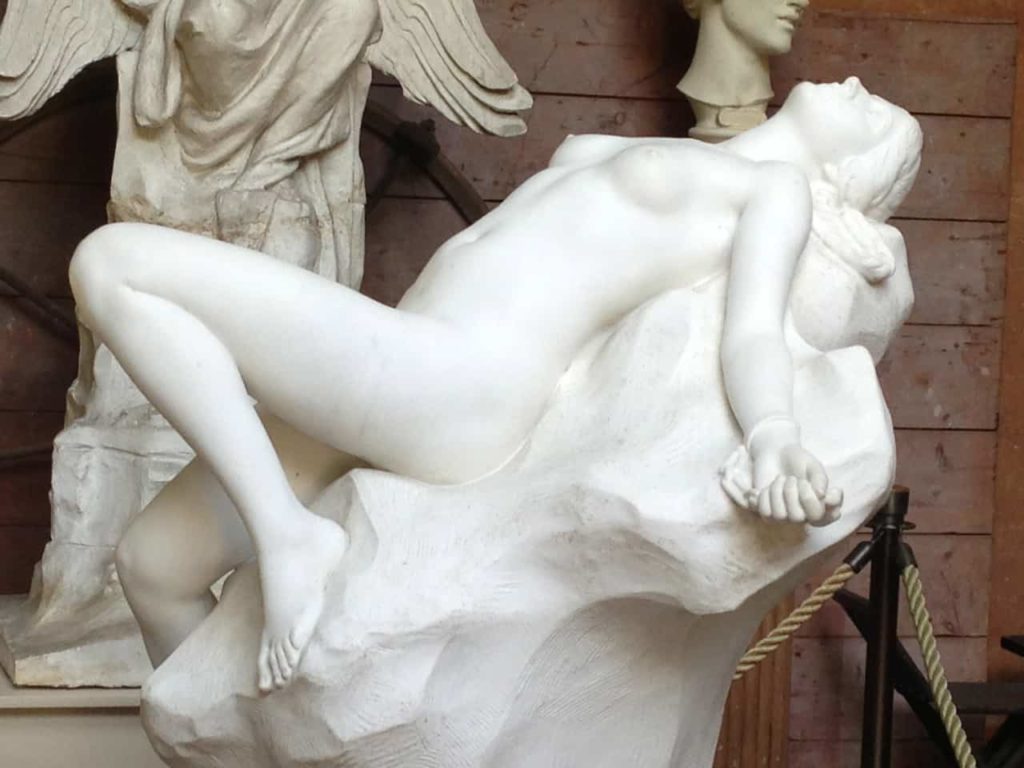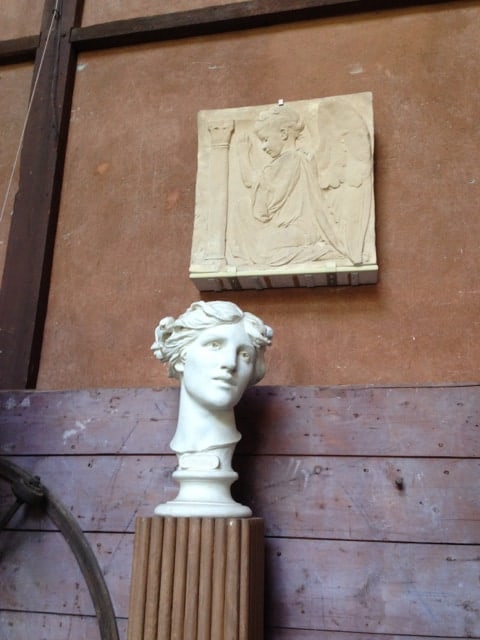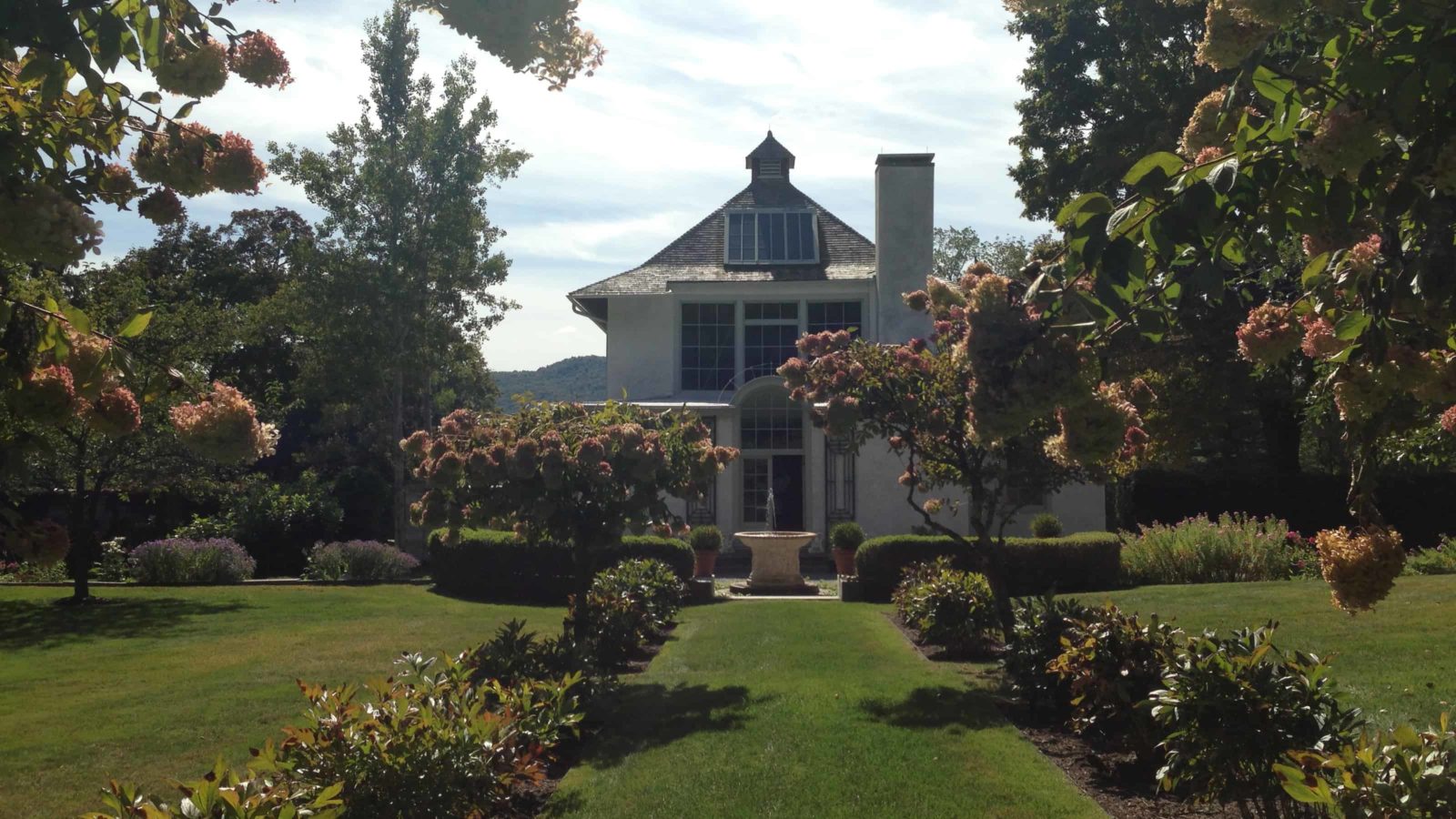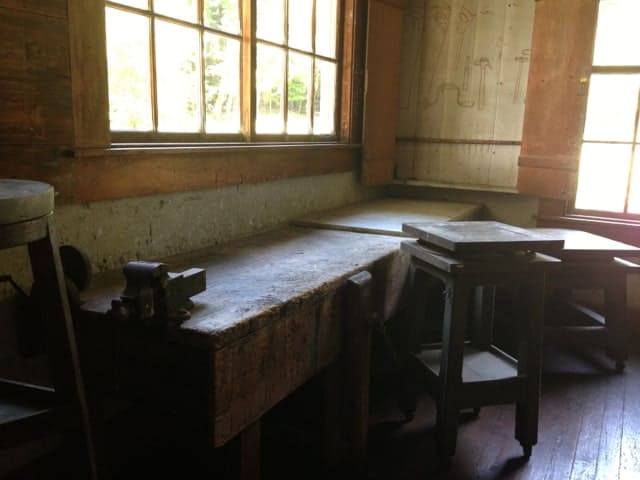Light comes through broad windows high on the wall and sloping in the roof — northern light. Bill Allen, a guide waiting in the studio to talk with visitors, explains that sculptors like ambient northern light because it stays consistent, no movement during the day, no change in color, no shifting shadows.

Gilded-Age sculptor Daniel Chester French designed his studio with tall north-facing windows. Photo by Kate Abbott
Daniel Chester French (1850-1931) designed this studio in Stockbridge, with a short length of railroad track for moving sculptures out into the sunlight and a small room off to the side for mixing plaster, and he crafted his best-known work here — the Lincoln Memorial.
Some art critics have called French one of the last Classical sculptors in America — and his contemporary, Augustus Saint-Gaudens, an early Modernist.
Saint-Gaudens, went to Paris in the 1870s as French went to Italy, and Allen saw him developing a different style there, active and natural. He thinks the early years of French’s artistic development in Italy influenced him all his life — in the formal, ideal smoothness of his figures.
French’s studio echoes the classical style of that memorial and its colonnade — he worked inside walls as shell-grey as limestone or stucco, with white columns on the porch, and pale marble figures line the cool, bare room: politicians, generals and Greek mythological characters, Lincoln seated on his massive chair, a military man on horseback, Andromeda chained to her rock by the sea.
Allen, looking around at serene marble faces with respect, saw French in the shifting art world of his time. French learned his art and reached his height among many different movements: the brilliant flashing color of the impressionists, the abstract geometries of the Modernists, the broad horizontal lines of Frank Lloyd Wright.
French learned his art from Neoclassicists — part of a 19th-century movement in art and architecture reaching back to Greek and Roman influences. Later in his life, as a member of the Commision on Fine Arts, he fought for it.
As a young man, French studied in New York City with Neoclassical artists and architects and then, from 1874 to 1876, traveled to Florence, Firenze. Many American sculptors lived in Italy then, Allen said, in Florence and Rome, because Italy had marble and artisan who knew how to work it — and Italy had well-to-do Americans on the grand tour, looking for souvenirs of their travels.

Daniel Chester French's Andromeda recalls the mythical figure. Photo by Kate Abbott
But French came to Italy as the center of the innovative art world was shifting to France. By the 1850s, Paris was becoming a center of avant garde art. Italy is known for marble, Allen said, but in the mid-1800s sculptors across Europe and America were turning their focus toward bronze.
“You can do things with bronze that you can’t do with marble,” he said.
Bronze figures can flex in flowing, sweeping gestures rather than rigid and straight lines. Bronze can take shapes that in marble would be top-heavy and unbalanced or breakable, like a horse’s slender legs.
Ten years after his trip to Italy, French went back to Europe, Allen said, and this time he went to Paris. In 1886 Paris was the center of the Classically inspired beaux arts movement that influenced major American architecture for many years, from Grand Central Station to the New York Public Library to Columbia University.
But after more than 100 years, the school of Beaux Arts was reeling. The new Impressionists were holding their eighth exhibition in defiance of the Beaux Arts Salons that had repeatedly rejected them, and the Impressionists themselves were arguing over the inclusion of Mary Cassatt and Georges Seurat. Degas had recently held his only showing of sculpture and survived harsh criticism of his Little Dancer of 14 Years. Rodin — who had failed to get into the École des Beaux Arts as a young man — was at the height of his career, at work on The Burghers of Calais and challenging tradition.
To see the contrast, look from French’s studio to the works of Degas, Monet, Renoir and their fellows at the Clark Art Institute just up the road. Neoclassical art has a finished, polished and still quality, Allen said. Emerging against it, Impressionists and later Modernists emphasized movement and color.
“You don’t have to finish everything off perfectly,” he said. A Neoclassicist might show a rose sharply and clearly in a smooth surface of paint, where an impressionist would suggest petals with visible brush strokes.
Did French ever meet Rodin or Degas, and what would they have said to each other? He came to a Paris full of its own movement and color. Seen in context, his sombre, symmetrical faces and clean-lined bodies are not the inevitable outcome of long tradition. He chose them. And he kept to them all through his career.

A marble head sits on a shelf below a relief sculpture that Daniel Chester French's dauther, Margaret French Cresson, modelled for as a child. Photo by Kate Abbott
More than that, he defended them. He won the commission for the Lincoln Memorial in 1914, on the eve of World War I, as Modernism and Cubism were exploding to their heights and Frank Lloyd Wright was bringing the wide horizons of the prairie and Mayan and American Indian aesthetics into new buildings.
In “Assassination Vacation,” a walk into Presidential history beginning with Abraham Lincoln, Sarah Vowell explains that Classicism and Modernism clashed over the Lincoln Memorial itself. French sat on the committee that chose the architect for the memorial, and they chose a a Classical designer over any architect from the Frank Lloyd Wright school — a controversial choice, since Lincoln came from Wright’s home ground along the Mississippi River. She loves the Lincoln Memorial as it is, but she muses, if a Wright-influenced architect like Louis Sullivan had designed his own tribute to Lincoln, what would it have been like?
Walking through the woods around French’s studio on a fall day and looking at the contemporary sculptures along the paths — woven branches, seed-pod-like boats on stilts, red-bound books hanging in a maple tree like fall leaves — it’s easy to wonder. If French and Saint-Gaudens and Sullivan sat on the porch here, looking over the fields, and debated the design of the Lincoln Memorial and the movements in the art world around them, imagine what they might have said.
Or if a contemporary bronze sculptor like Andrew DeVries of Lenox sat down with a contemporary Illini or Dakota or Shawnee architect from the nations of Lincoln’s home state, what might they imagine together?


